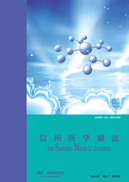Volume 59, Issue 4
Displaying 1-15 of 15 articles from this issue
- |<
- <
- 1
- >
- >|
Foreword
-
2011 Volume 59 Issue 4 Pages 211-212
Published: 2011
Released on J-STAGE: August 26, 2011
Download PDF (187K)
Review
-
2011 Volume 59 Issue 4 Pages 213-222
Published: 2011
Released on J-STAGE: August 26, 2011
Download PDF (1004K)
Originals
-
2011 Volume 59 Issue 4 Pages 223-228
Published: 2011
Released on J-STAGE: August 26, 2011
Download PDF (201K) -
2011 Volume 59 Issue 4 Pages 229-237
Published: 2011
Released on J-STAGE: August 26, 2011
Download PDF (390K) -
2011 Volume 59 Issue 4 Pages 239-247
Published: 2011
Released on J-STAGE: August 26, 2011
Download PDF (245K) -
2011 Volume 59 Issue 4 Pages 249-257
Published: 2011
Released on J-STAGE: August 26, 2011
Download PDF (735K)
Case Reports
-
2011 Volume 59 Issue 4 Pages 259-263
Published: 2011
Released on J-STAGE: August 26, 2011
Download PDF (428K) -
2011 Volume 59 Issue 4 Pages 265-271
Published: 2011
Released on J-STAGE: August 26, 2011
Download PDF (441K)
Editorial
-
2011 Volume 59 Issue 4 Pages 273-279
Published: 2011
Released on J-STAGE: August 26, 2011
Download PDF (211K)
Current Topics
-
2011 Volume 59 Issue 4 Pages 281-284
Published: 2011
Released on J-STAGE: August 26, 2011
Download PDF (380K)
Round the World
-
2011 Volume 59 Issue 4 Pages 285
Published: 2011
Released on J-STAGE: August 26, 2011
Download PDF (164K)
My Choice of Speciality
-
2011 Volume 59 Issue 4 Pages 286
Published: 2011
Released on J-STAGE: August 26, 2011
Download PDF (212K)
Book Review by Author
-
2011 Volume 59 Issue 4 Pages 287
Published: 2011
Released on J-STAGE: August 26, 2011
Download PDF (162K)
Abstract of Meetings
-
2011 Volume 59 Issue 4 Pages 289-296
Published: 2011
Released on J-STAGE: August 26, 2011
Download PDF (465K) -
2011 Volume 59 Issue 4 Pages 297-300
Published: 2011
Released on J-STAGE: August 26, 2011
Download PDF (326K)
- |<
- <
- 1
- >
- >|
